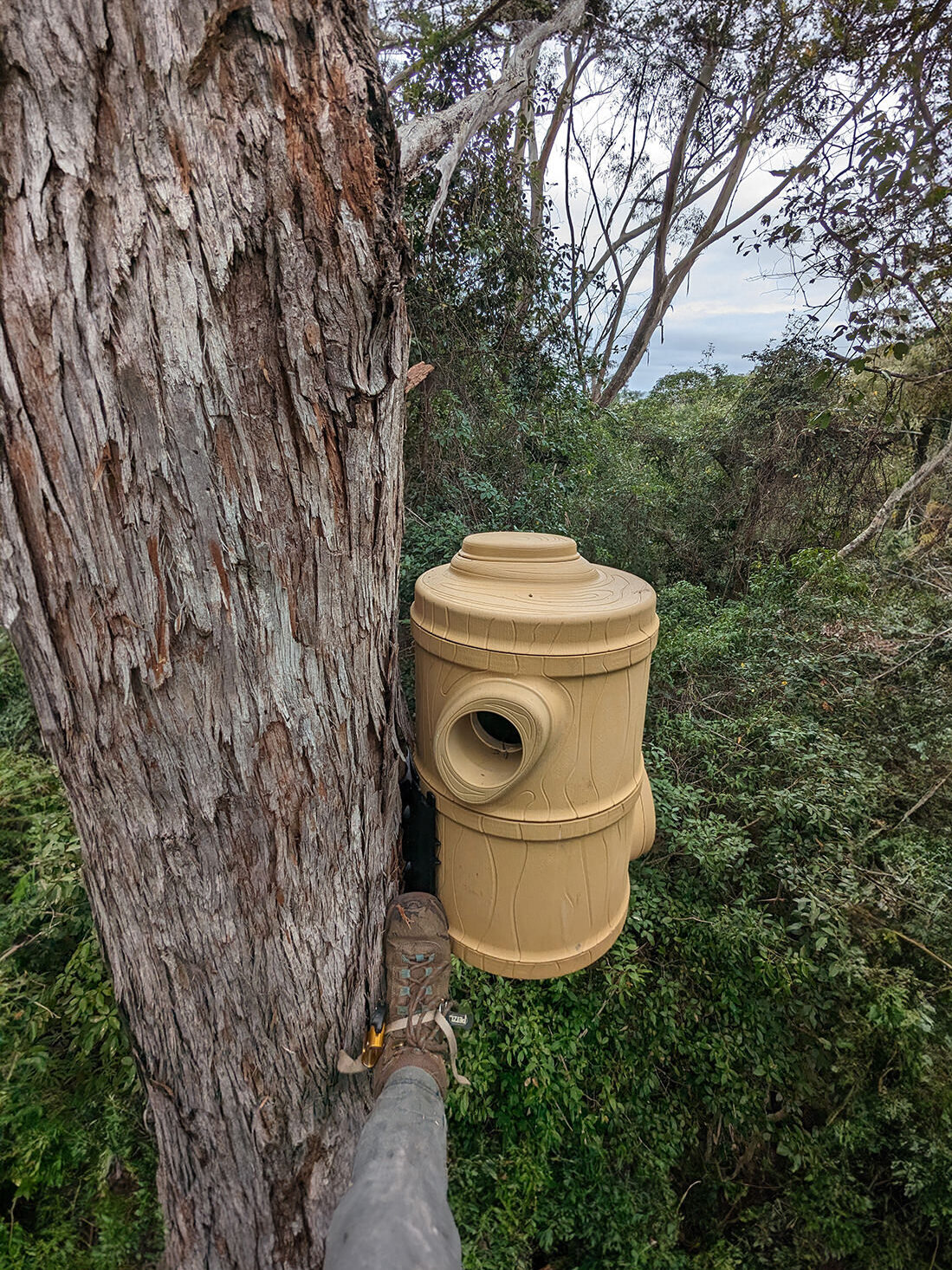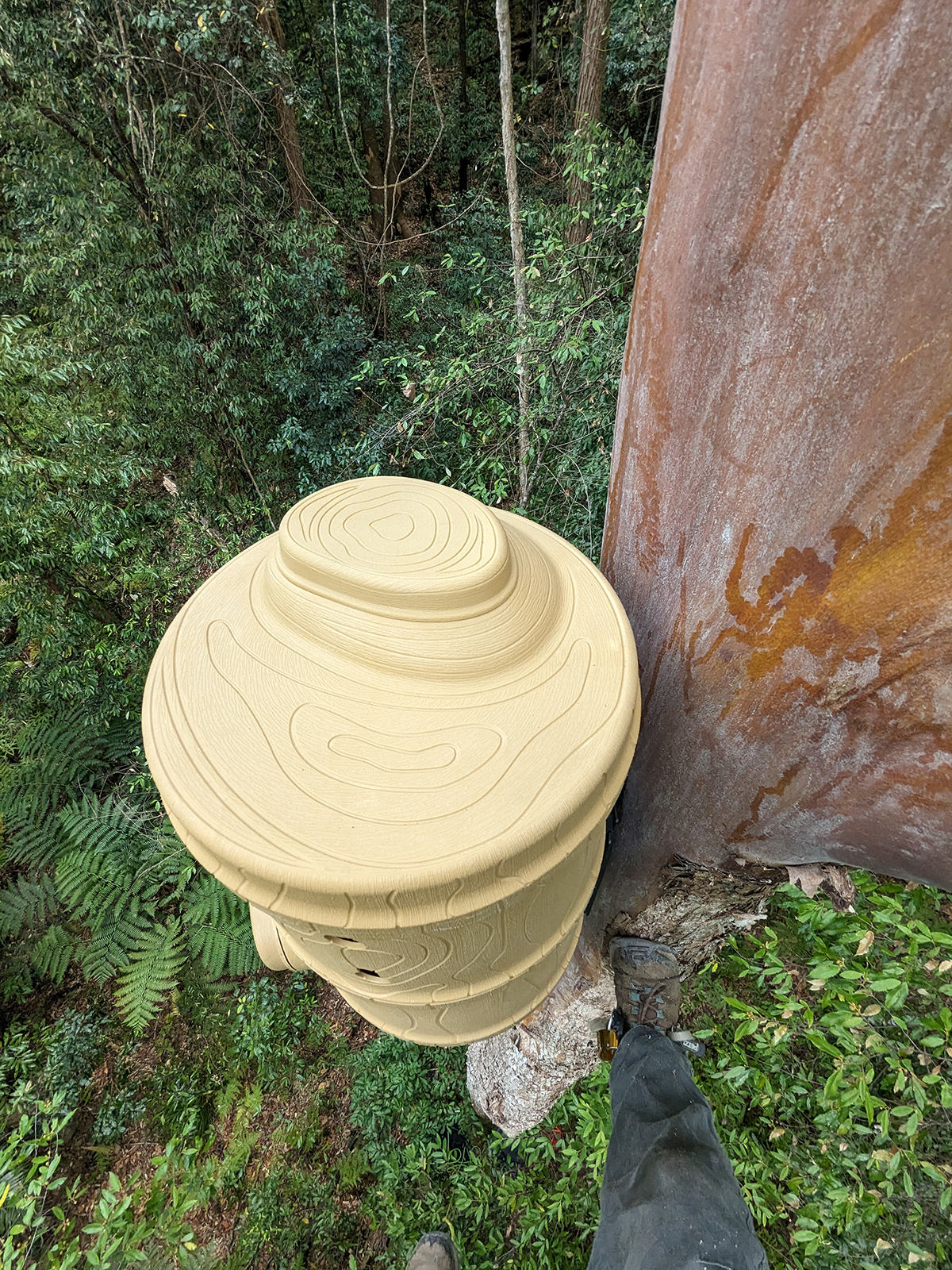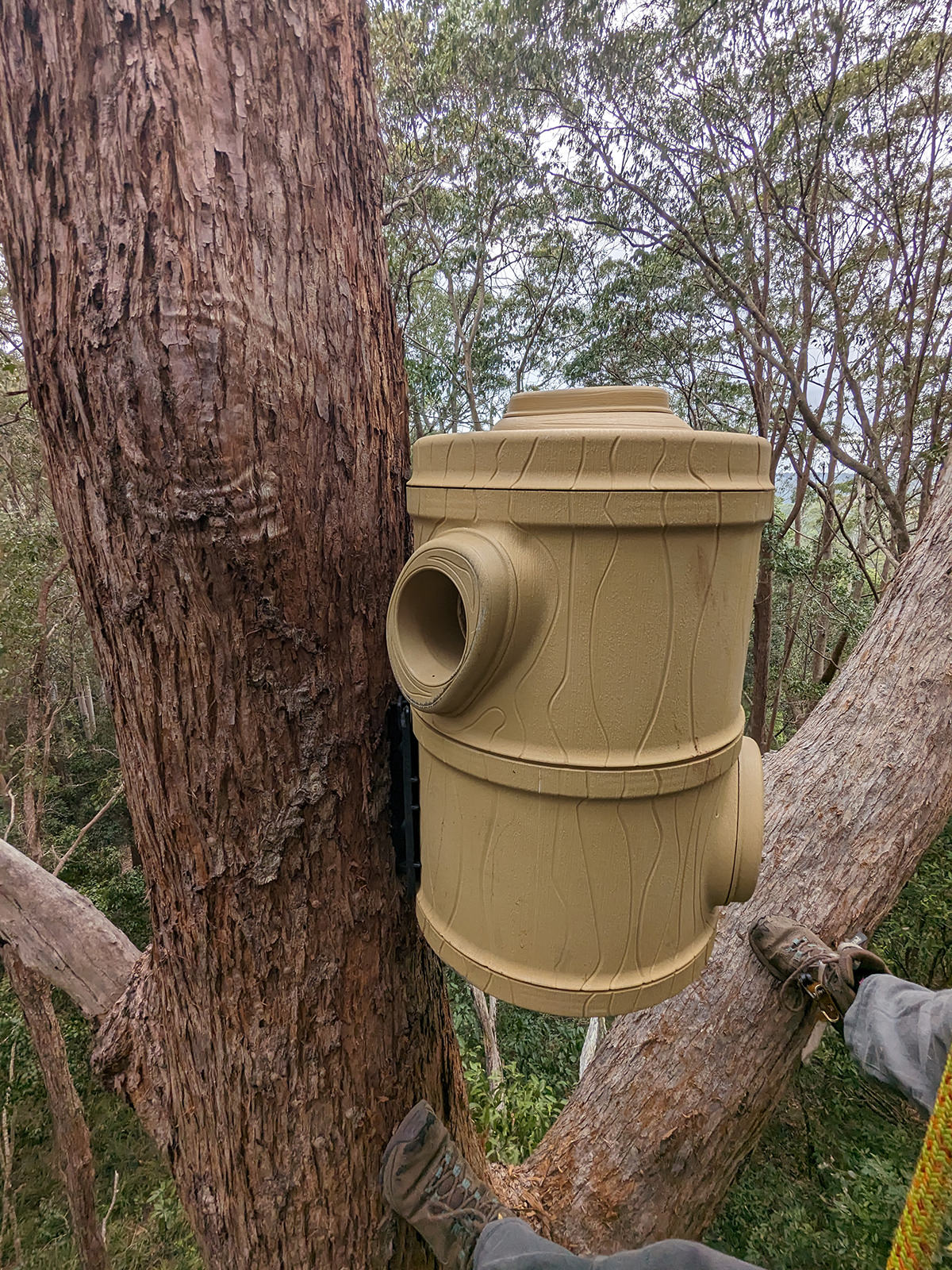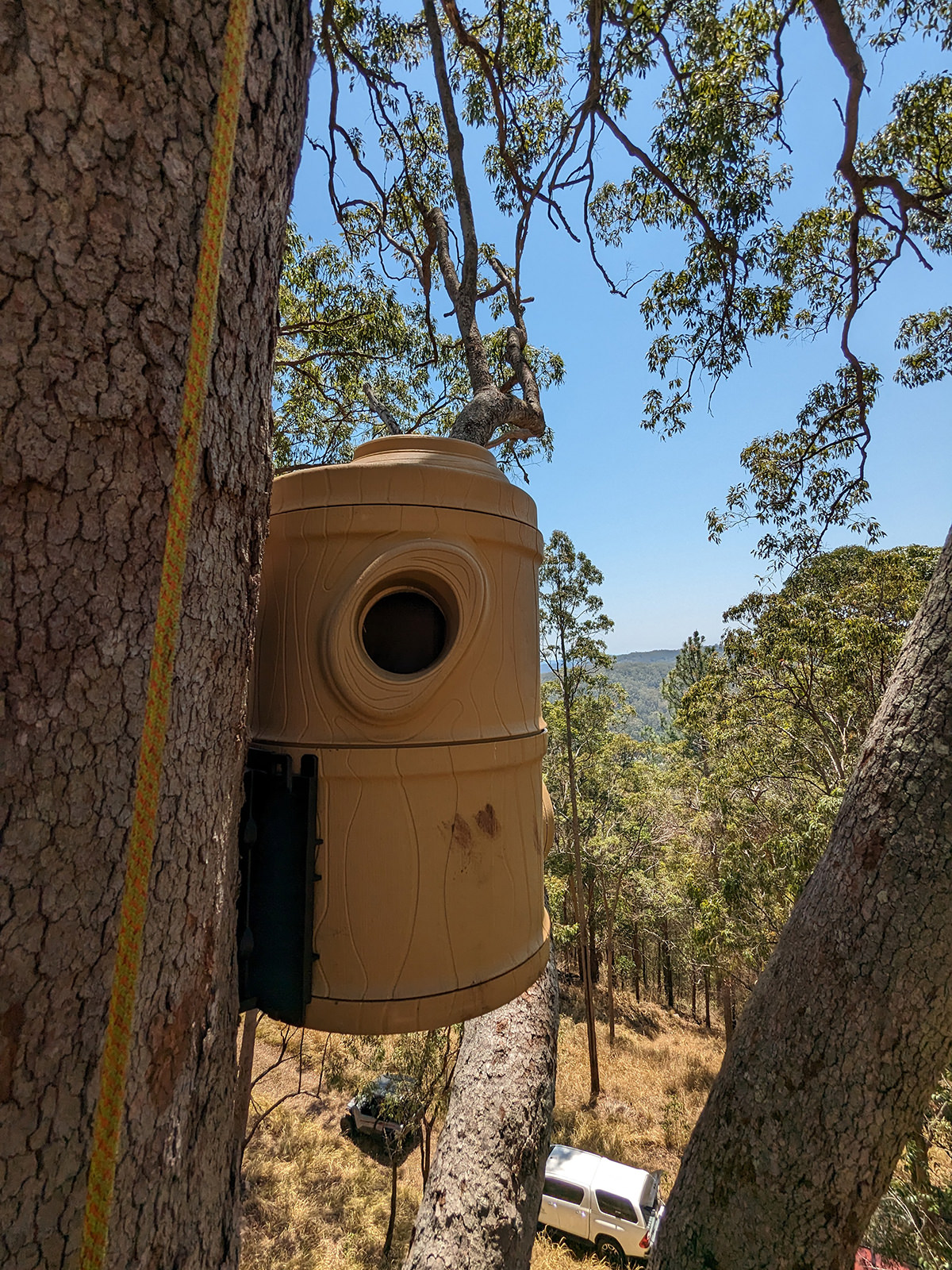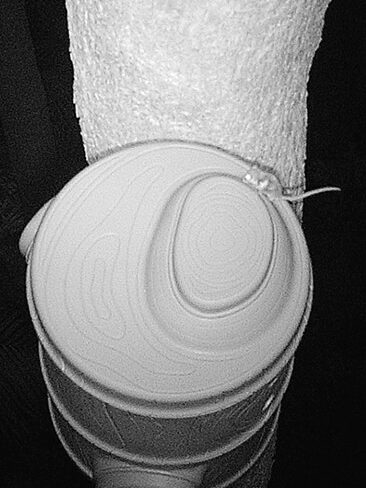Spot the nest box in this eucalypt forest on a sandstone ridge in the Mooloolah Valley.
The eucalypt forests of SEQ are home to a variety of gliders including the largest and perhaps most iconic, the Greater Glider (Petauroides volans). In 2022, the Greater Glider was re-listed from Vulnerable to Endangered nationally as it continues to decline across the east coast of Australia. A recent study by Macgregor et al. (2020) identified there may be three distinct species of Greater Glider including the Northern Greater Glider (P. minor), Central Greater Glider (P. armillatus) and Southern Greater Glider (P. volans). However, at this time and for the purposes of this article, I will hereafter refer to the local species in SEQ (Southern and Central Greater Gliders) as Greater Gliders.
Greater Gliders primarily forage on eucalypt leaves and require mature, hollow-bearing trees (typically eucalypts). Suitable hollows are critical as they are used for shelter during the daytime and for breeding.
One of the greatest threats to Greater Gliders is loss of habitat due to the decline of large hollow-bearing trees. Land clearing and wildfires have contributed to this habitat loss in SEQ over recent decades. The 2018 bushfires in central and southern Queensland and the more recent 2019-2020 wildfires impacted at least 30% of Greater Glider habitat throughout their range. As growing threats of habitat loss continue to mount, and with the impacts of a changing climate and land clearing, there are many projects across the east coast focused on restoring habitat and providing supplementary hollows for Greater Gliders.
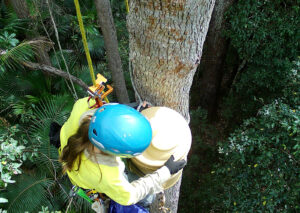
Greater Gliders have relatively small home ranges of 1-4 hectares in areas of good quality, highly connected habitat with abundant hollows. They are known to have a wider home range in less fertile areas like central Queensland. In SEQ, studies have shown that individuals require a minimum of 2-4 den (hollow-bearing) trees for every 2 hectares of suitable forest habitat. However, some records show individuals can use up to 20 den trees. Greater Gliders typically give birth to single young in March to June (winter).
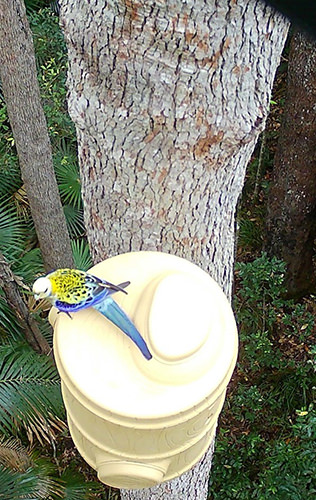
Over the past year the Sunshine Coast Land for Wildlife team have developed a pilot project to install 18 Habitech nest boxes across several Land for Wildlife properties on the Sunshine Coast.
All nest boxes were installed within four distinct defined habitat patches with known occurrences of Greater Gliders. These four patches were identified as suitable Greater Glider habitat areas based on an assessment of ecosystems, physical barriers in the landscape (e.g. highways, suburbia) and the known home range (approximately 2ha) for Greater Glider females in SEQ (Eyre et al. 2022). All identified habitat patches contain hollow-bearing trees suitable for denning as well as feed trees and habitat connectivity across the landscape.
This project aims to identify hollow-dependant fauna investigating and using these nest boxes while providing more habitat for Greater Gliders.
All nest boxes were installed between 10-14 metres high on eucalypt species including bloodwoods (Corymbia sp.), Grey Gums (Eucalyptus propinqua) and Tallowwoods (Eucalyptus microcorys), which are known to be used as denning or feed trees by Greater Gliders in Queensland. Habitech nest boxes are made from long-lasting, UV-stable plastic with timber linings to create a well-insulated, modular and stackable nest box with potential for multiple entry configurations.
Nest boxes were installed in October – November 2023 and will be monitored using a combination of techniques including mounted fauna cameras, spotlighting and from the ground with a fauna camera on an extension pole. In addition, Land for Wildlife Officers and landholders will undertake surveys including spotlighting and stag watching.
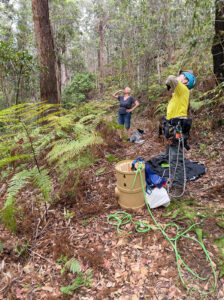
One of the monitoring techniques used as part of our project includes fixed fauna cameras installed above the nest boxes to monitor real-time fauna movement. Solar powered fauna cameras were skilfully installed on four nest boxes by Wildlife Preservation Society Queensland’s Matt Cecil and Maaike Hofman.
Although Blackbutts (Eucalyptus pilularis) are a known denning trees for Greater Gliders in SEQ and the dominant canopy species throughout the project area, these species were omitted from having nest boxes installed. This is due to their large lateral limbs posing potential threats to camera mounts during storms and high wind events.
This exciting project will run over the next 12 months, and we hope that by using a combination of monitoring techniques coupled with the installation of nest boxes across four distinct patches in the landscape that we can provide more sheltering and denning sites for Greater Gliders on the Sunshine Coast. In addition, we hope to also gather insight into the local Greater Glider habitat preferences and support landholders in continuing their conservation and restoration goals for this federally threatened species.
To learn more about Greater Gliders and other locally threatened glider species visit the Queensland Glider Network at wildlife.org.au.
References and Further Reading
Eyre TJ, Smith GC, Venz MF, et. al. (2022). Guide to greater glider habitat in Queensland. Report prepared for the Dept of Agriculture, Water and the Environment. DES, Brisbane.
Eyre T J (2005). Hollow-bearing trees in large glider habitat in south-east Queensland, Australia: abundance, spatial distribution and management. Pacific Conservation Biology, 11, 23–37.
Kavanagh RP, Lambert MJ (1990). Food selection by the greater glider, Petauroides volans: is foliar nitrogen a determinant of habitat quality? Australian Wildlife Research, 17, 285–299.
Foley WJ, Lawler IR, Moore BD et. al. (2006). Diet selection in marsupial folivores of Eucalyptus: the role of plant secondary metabolites. In: Goldingay RL & Jackson SM (Eds.) The Biology of Possums and Gliders. Surrey Beatty & Sons, pp. 207–221.
Macgregor D, Padovan A, Georges A et. al. (2020). Genetic evidence supports three previously described species of greater glider, Petauroides volans, P. minor, and P. armillatus. Scientific Reports, 10, 19284.
Ward M, Tulloch AT, Radford JQ et. al. (2020). Impact of 2019–2020 mega-fires on Australian fauna habitat. Nature Ecology & Evolution, 4, 1321-1326.
Article and photos by De-Anne Attard
Land for Wildlife Officer Sunshine Coast Council
Additional photos WPSQ

